Fabrication of Color Glass with High Light Transmittance by Pearlescent Pigments and Optical Adhesive
Abstract
:1. Introduction
2. Materials and Methods
2.1. Fabrication of Colored Glass Using Pearlescent Pigments
2.2. Lamination Process of Colored Glass on Solar Cells
3. Results and Discussion
3.1. Thickness of Color Films and the Optical Characteristics of the Colored Glass
3.2. Solar Efficiency of PV Cells with Colored Glass and Stability Analysis of the Colored Glass
4. Conclusions
Supplementary Materials
Author Contributions
Funding
Institutional Review Board Statement
Informed Consent Statement
Data Availability Statement
Conflicts of Interest
References
- Henemann, A. BIPV: Built-in solar energy. Renew. Energy Focus 2008, 9, 14–19. [Google Scholar] [CrossRef]
- Ceron, I.; Caamano-Martin, E.; Neila, F.-J. State of the art of building integrated photovoltaic products. Renew. Energy 2013, 58, 127–133. [Google Scholar] [CrossRef] [Green Version]
- Shukla, A.-K.; Sudhakar, K.; Baredar, P. Recent advancement in BIPV product technologies: A review. Energy Build. 2017, 140, 188–195. [Google Scholar] [CrossRef]
- Enkvist, P.-A.; Dinkel, J.; Lin, C. Impact of the Financial Crisis on Carbon Economics: Version 2.1 of the Global Greenhouse Gas Abatement Cost Curve; McKinsey & Company: Atlanta, GA, USA, 2010. [Google Scholar]
- Tombazis, A.-N. Architectural design: A multifaceted approach. Renew. Energy 1994, 5, 893–899. [Google Scholar] [CrossRef]
- Yang, Y.; Wang, Q.; Xiu, D.; Zhao, Z.; Sun, Q. A building integrated solar collector: Allceramic solar collector. Energy Build. 2013, 62, 15–17. [Google Scholar] [CrossRef]
- Sioshansi, F.-P. Distributed Generation and Its Implications for the Utility Industry; Elsevier: San Diego, CA, USA, 2014; pp. 92101–94495. [Google Scholar]
- Amado, M.; Poggi, F. Solar Energy Integration in Urban Planning: GUUD Model. Energy Procedia 2014, 50, 277–284. [Google Scholar] [CrossRef] [Green Version]
- Erlat, G.-A.; Henry, B.-M.; Grovenor, C.-R.-M.; Briggs, A.-G.-D.; Chater, R.-J.; Tsukahara, Y. Mechanism of Water Vapor Transport through PET/AlOxNy Gas Barrier Films. J. Phys. Chem. B 2004, 108, 883–890. [Google Scholar] [CrossRef]
- Wolf, M. Performance analysis of combined heating and photovoltaic power systems for residences. Energy Convers. 1976, 16, 79–90. [Google Scholar] [CrossRef]
- Florschuetz, L.-W. Extension of the Hottel-Whiller model to the analysis of combined photovoltaic/thermal flat plate collectors. Sol. Energy 1979, 22, 361–366. [Google Scholar] [CrossRef]
- Kippelen, B.; Brédas, J.-L. Organic photovoltaics. Energy Environ. Sci. 2009, 2, 251–261. [Google Scholar] [CrossRef]
- Brabec, C.-J. Organic photovoltaics: Technology and market. Sol. Energy Mater. Sol. Cells 2004, 83, 273–292. [Google Scholar] [CrossRef]
- Su, Y.-W.; Lan, S.-C.; Wei, K.-H. Organic photovoltaics. Mater. Today 2012, 15, 554–562. [Google Scholar] [CrossRef]
- Schüler, A.; Roecker, C.; Boudaden, J.; Oelhafen, P.; Scartezzini, J.-L. Potential of quarter wave interference stacks for colored thermal solar collectors. Sol. Energy 2005, 79, 122–130. [Google Scholar] [CrossRef]
- Mertin, S.; Hody-Le, C.-V.; Joly, M.; Mack, I.; Oelhafen, P.; Scartezzini, J.-L.; Schüler, A. Reactively sputtered coatings on architectural glazing for colored active solar thermal façades. Energy Build. 2014, 68, 764–770. [Google Scholar] [CrossRef]
- Schueler, A.; Roecker, C.; Scartezzini, J.-L.; Boudaden, J.; Oelhafen, P. Designing thin film multilayer for colored glazed thermal collectors. In Proceedings of the EuroSun 2004, Freiburg im Breisgau, Germany, 20–23 June 2004; Volume 2, pp. 858–865. Available online: https://www.osti.gov/etdeweb/biblio/20672065 (accessed on 6 December 2021).
- BJ Power, Co., Ltd. Solar Power System, Solar Modules. 2020. Available online: https://bjpower.en.ec21.com/ (accessed on 6 December 2021).
- SwssInso. SwissINSO—Technology. 2020. Available online: https://www.swissinso.com/technology (accessed on 6 December 2021).
- Ahn, H.-S.; Gasonoo, A.; Jang, E.-J.; Kim, M.-H.; Lee, J.-H.; Choi, Y. Transition Metal Oxide Multi-Layer Color Glass for Building Integrated Photovoltaic System. Inst. Korean Electr. Electron. Eng. 2019, 23, 1128–1133. [Google Scholar] [CrossRef]
- Gasonoo, A.; Ahn, H.-S.; Kim, M.-H.; Lee, J.-H.; Choi, Y. Metal Oxide Multi-Layer Color Glass by Radio Frequency Magnetron Sputtering for Building Integrated Photovoltaic System. Inst. Korean Electr. Electron. Eng. 2018, 22, 1056–1061. [Google Scholar] [CrossRef]
- Gasonoo, A.; Ahn, H.-S.; Lim, S.-M.; Lee, J.-H.; Choi, Y. Color Glass by Layered Nitride Films for Building Integrated Photovoltaic (BIPV) System. Crystals 2021, 11, 281. [Google Scholar] [CrossRef]
- Gasonoo, A.; Ahn, H.-S.; Jang, E.-J.; Kim, M.-H.; Gwag, J.S.; Lee, J.-H.; Choi, Y. Fabrication of Multi-Layer Metal Oxides Structure for Colored Glass. Materials 2021, 14, 2437. [Google Scholar] [CrossRef] [PubMed]
- Rao, C.-N.-R. Transition Metal Oxides. Annu. Rev. Phys. Chem. 1989, 40, 291–326. [Google Scholar] [CrossRef]
- DNF Co., Ltd. DNF BIPV Solar Color Glass. 2021. Available online: https://www.dnfsolution.com/sub02/sub03.html (accessed on 6 December 2021).
- CQV Co., Ltd. Creation of Quality Value. Available online: https://cqv.co.kr/english/product01.htm (accessed on 6 December 2021).
- Jeo, H.-J. Optical thin film practice. Hooks Hill. 2015, 1, 3. [Google Scholar]

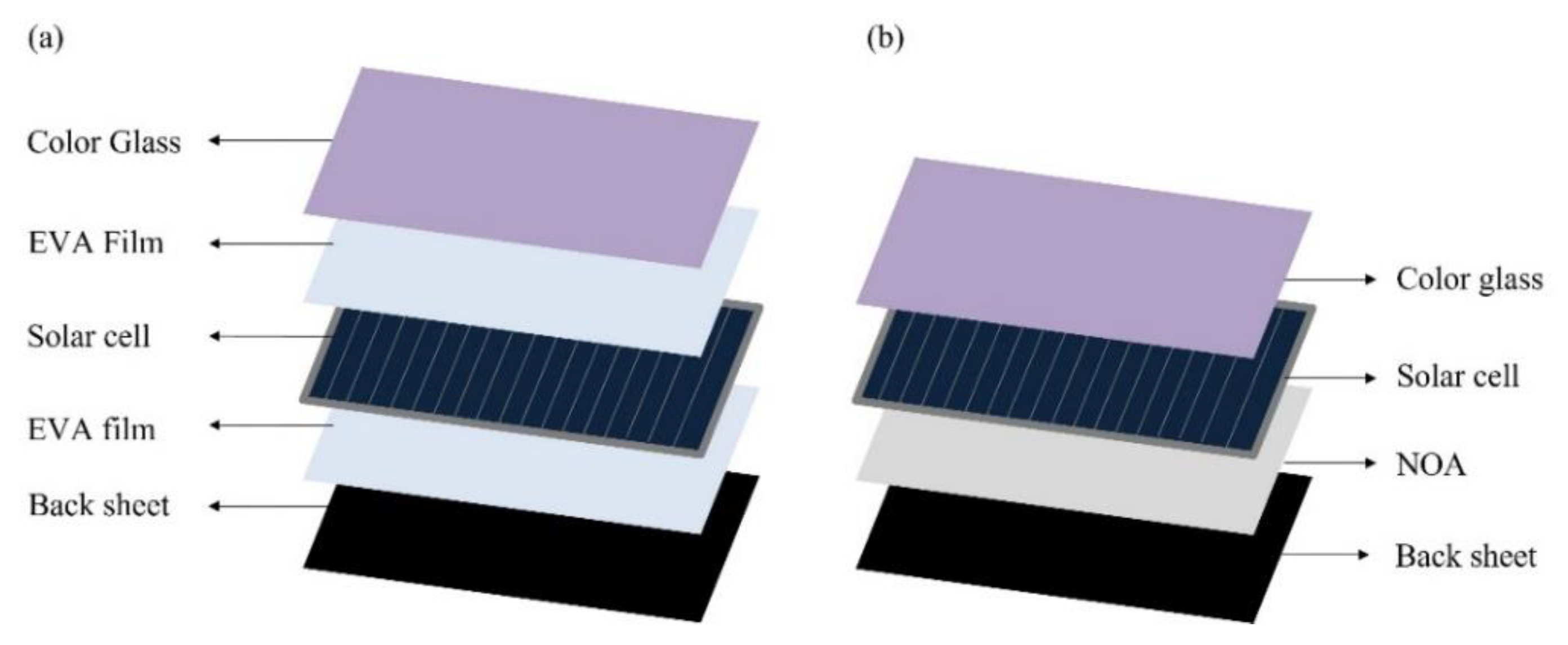
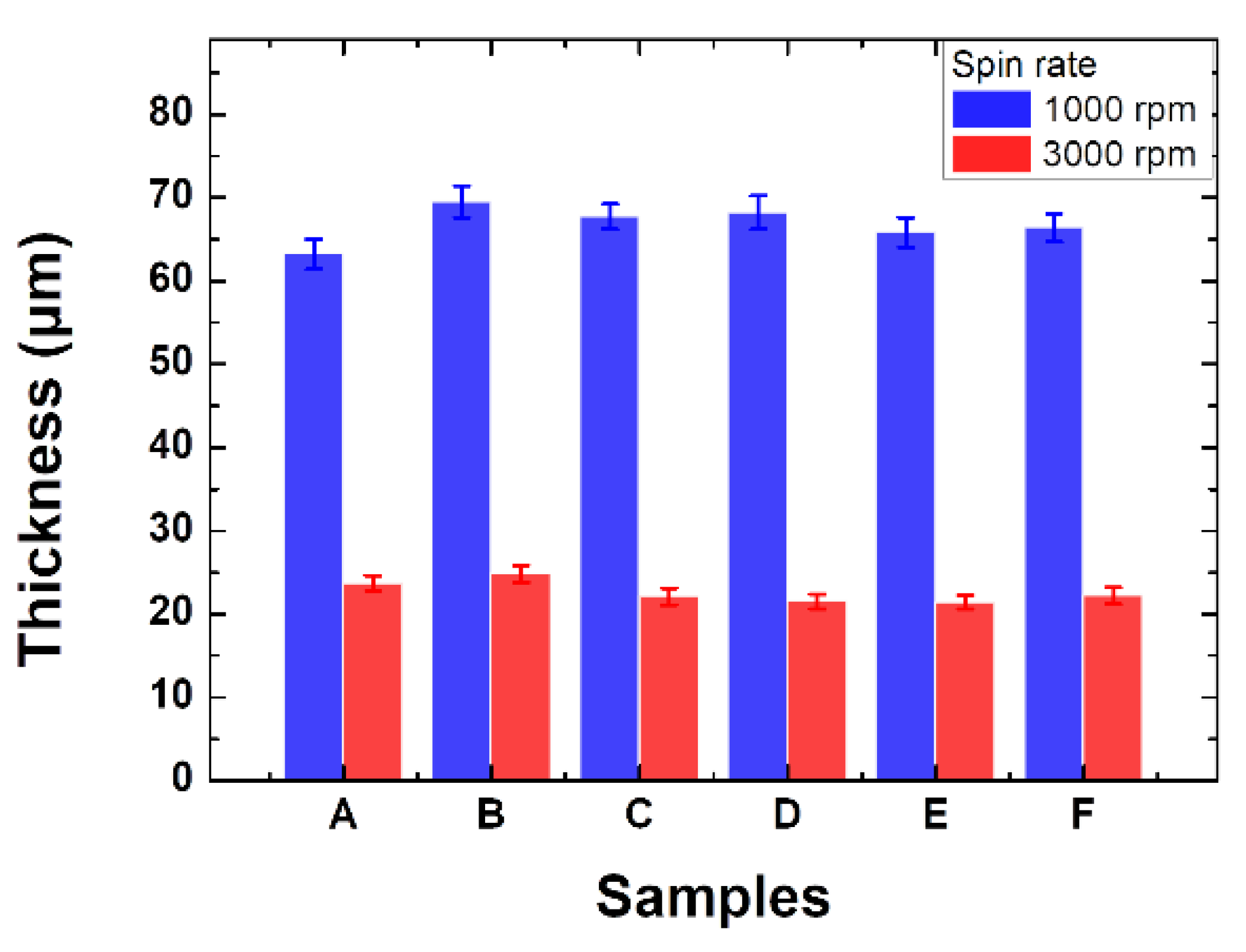
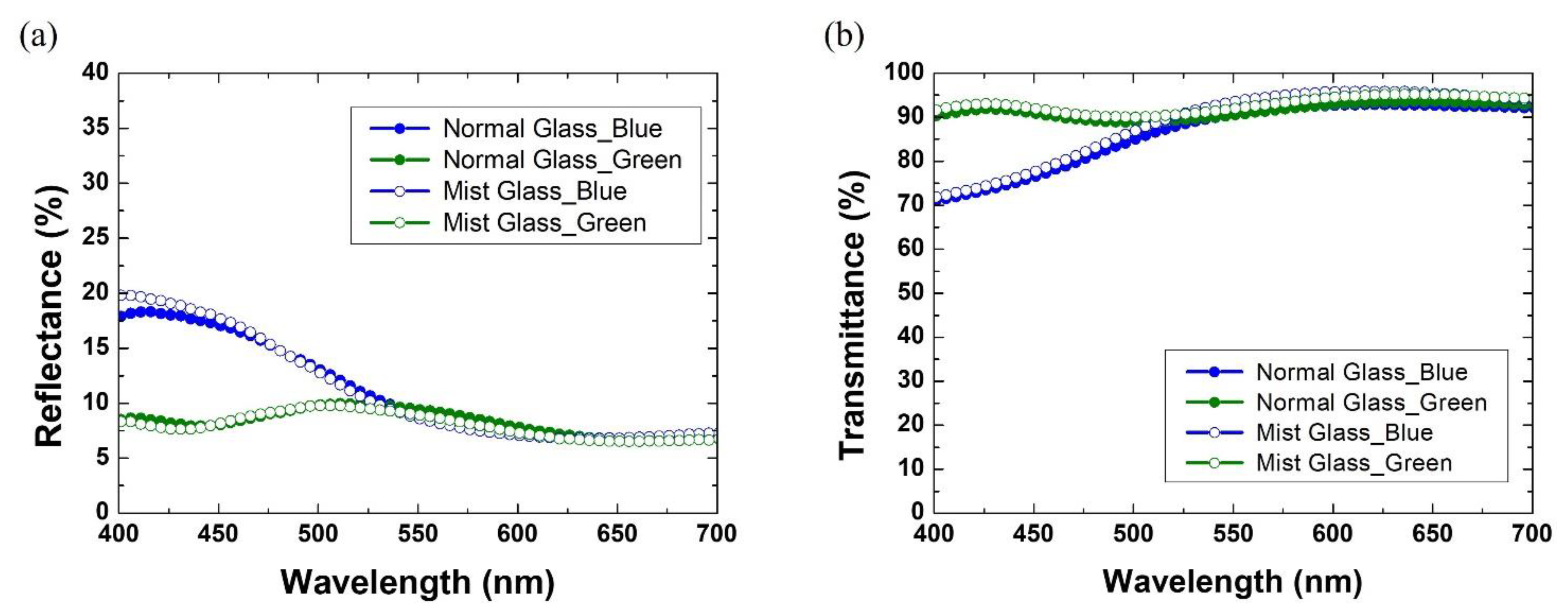

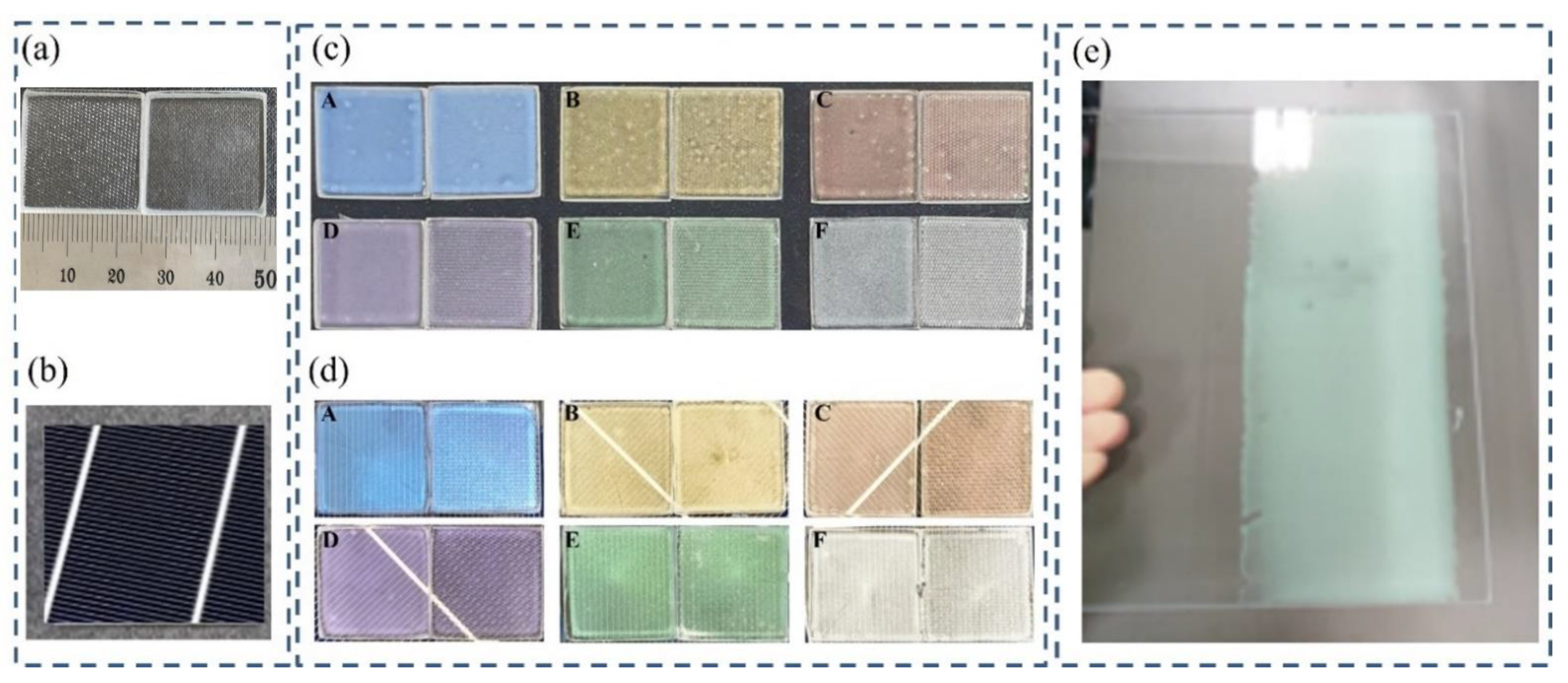
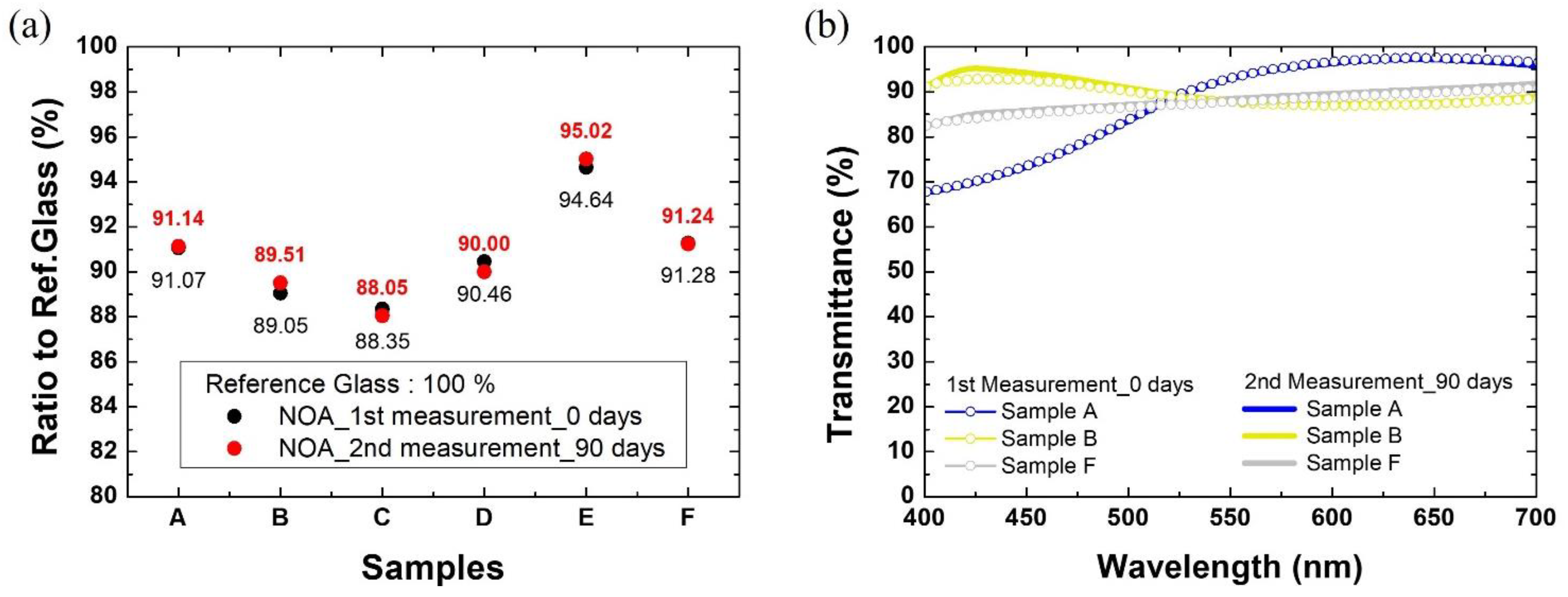
| Sample | Layer Structure | Reflectance Range (nm) | Color |
|---|---|---|---|
| A | Glass/A-781K + NOA63 | 460–480 | Splendor Blue |
| B | Glass/AX-701K + NOA63 | 590–610 | Dazzling Gold |
| C | Glass/AX-741K + NOA63 | 630–650 | Dazzling Red |
| D | Glass/AX-761K + NOA63 | 410–430 | Dazzling Violet |
| E | Glass/AX-791K + NOA63 | 520–540 | Dazzling Green |
| F | Glass/AX-901K + NOA63 | 350–780 | Dazzling Standard |
Publisher’s Note: MDPI stays neutral with regard to jurisdictional claims in published maps and institutional affiliations. |
© 2022 by the authors. Licensee MDPI, Basel, Switzerland. This article is an open access article distributed under the terms and conditions of the Creative Commons Attribution (CC BY) license (https://creativecommons.org/licenses/by/4.0/).
Share and Cite
Ahn, H.-S.; Gasonoo, A.; Lim, S.-M.; Lee, J.-H.; Choi, Y. Fabrication of Color Glass with High Light Transmittance by Pearlescent Pigments and Optical Adhesive. Materials 2022, 15, 2627. https://doi.org/10.3390/ma15072627
Ahn H-S, Gasonoo A, Lim S-M, Lee J-H, Choi Y. Fabrication of Color Glass with High Light Transmittance by Pearlescent Pigments and Optical Adhesive. Materials. 2022; 15(7):2627. https://doi.org/10.3390/ma15072627
Chicago/Turabian StyleAhn, Hyeon-Sik, Akpeko Gasonoo, Seong-Min Lim, Jae-Hyun Lee, and Yoonseuk Choi. 2022. "Fabrication of Color Glass with High Light Transmittance by Pearlescent Pigments and Optical Adhesive" Materials 15, no. 7: 2627. https://doi.org/10.3390/ma15072627







